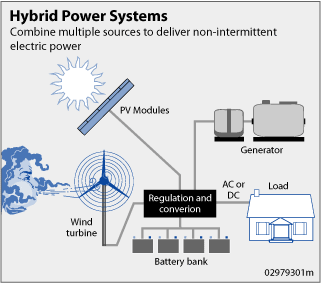Donald Swift-Hook, of the World Renewable Energy Network (who publishes the journal) in the United Kingdom, wrote in the journal that many different power storage options have been considered since the fuel cell was first conceived in 1838. These have included everything from thermal storage, compressed air and electro-chemical storage, and the recent focus on renewable energy - and wind in particular, which recently jumped past 10,000 megawatts installed capacity in the United States - has led to a renewed interest in the ability to store intermittently generated power.
The misconception, he contends, lies in the fact that all power sources have a certain degree of availability, which is never 100 percent, and wind power is no different. Instead of a zero "capacity credit," or the amount that a power source contributes to power generation, wind can actually provide as much as 38 to 58 percent capacity credit.
"The public are unduly concerned that wind and solar plant are intermittent but they fail to realise that, in fact, all plant has always been intermittent, including ‘base load’ nuclear," Swift-Hook wrote. "All their concerns are already well taken care of by the spare capacity that is needed for all plant, not just for wind."
And if one does start to bring stored energy into the equation, Swift-Hook has an answer for that too. Stored energy on a system that has multiple power sources, he claims, will come from the sources that are first to be shut down if the storage system is full or breaks down. Because wind and solar have no fuel costs - that is, once they are operating, the wind and sun provide free power - those are also the cheapest power sources on the system. Thus, they will be the last, not the first, to be shut down.
"This means that, even when storage is installed, grid-connected intermittent renewables like wind energy will never be stored (unless nothing else is available)," Swift-Hook wrote.
The end result of these jumps of logic is that when wind and solar power are merely part of a larger system of power generation, storage of the power they generate is largely unnecessary. So that battery bank in the Department of Energy image up top might not really be part of the picture, as long as the wind and sun aren't the only sources.
Even if that is true, though, others are still working on how best to handle the contributions of wind and solar to power mixes. In another paper in the same journal, researchers led by Dominik Heide of Johann Wolfgang Goethe Universität in Germany, modeled the optimal mix of wind and solar power based on seasonal contributions in Europe. In other words, the longer-term intermittent nature of renewables poses a challenge along with the day-by-day questions.
They found that because wind blows more in the winter and sun shines more in the summer, there is a specific mix that can allow for less energy to be stored in a future utopia where all energy is provided by renewable energy. That mix is 55 percent wind power and 45 percent solar, reducing the need for storage by a factor of two.
Of course, the authors of the latter paper also discuss the optimal breakdown during transitional periods when wind and solar account for larger percentages than now but not yet 100 percent of the total. But as we have already established that in a mixed power scenario storage is unnecessary anyway, we can skip that part.
Image via Wikimedia Commons and DOE.
Dave Levitan is the science writer for FactCheck.org, where he investigates the false and misleading claims about science that U.S. politicians occasionally make.




